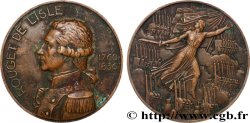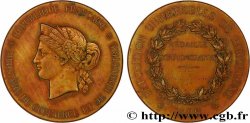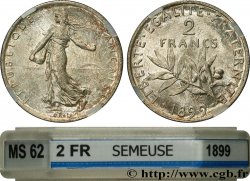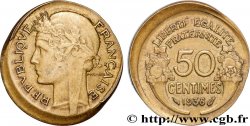v33_1745 - Faux de 20 francs Génie, Troisième République, désaxée 1896 Paris F.533/20 var.
MONNAIES 33 (2007)
Prezzo di inizio : 180.00 €
Valutazione : 400.00 €
Prezzo realizzato : 220.00 €
Numero di offerte : 2
Offerta maxima : 420.00 €
Prezzo di inizio : 180.00 €
Valutazione : 400.00 €
Prezzo realizzato : 220.00 €
Numero di offerte : 2
Offerta maxima : 420.00 €
Tipo : Faux de 20 francs Génie, Troisième République, désaxée
Data: 1896
Nome della officina / città: Paris
Quantità coniata : ---
Metallo : oro
Titolo in millesimi : 900 ‰
Diametro : 21,29 mm
Asse di coniazione : 5 h.
Peso : 6,47 g.
Orlo : inscrite en relief ***** DIEU * PROTEGE * LA * FRANCE
Grado di rarità : R2
Commenti sullo stato di conservazione:
Aucune usure mais des reliefs mous
N° nelle opere di riferimento :
Diritto
Titolatura diritto : RÉPUBLIQUE FRANÇAISE.
Descrittivo diritto : Génie de la République, debout à droite, gravant une Table vierge sur un cippe, accosté d'un faisceau vertical surmonté d'une main de justice à gauche et d'un coq à droite ; signé Dupré cursif au-dessous.
Rovescio
Titolatura rovescio : LIBERTÉ ÉGALITÉ FRATERNITÉ// 20/ FRANCS/ 1896// A.
Descrittivo rovescio : dans une couronne de chêne fermée.
Commento
L’analyse de l’aspect est intéressante car les listels sont francs et aigus, la tranche superbe est vive alors que les plats sont un peu mous. La monnaie n’a pas circulé mais a été fabriquée à partir de moulages puis marquée sur la tranche par un moyen mécanique. Il est probable que le faussaire ait cherché à réaliser la plus belle tranche possible, peut-être pour faire des échange dans des rouleaux.
On note un poids assez exact et un or apparemment au titre, ce qui permet de dater cette pièce de la crise du bi-métallisme, au tournant du siècle. On reste perplexe sur la négligence d’avoir fabriqué la pièce en axe à 5 heures : un faussaire ne devrait-il pas avoir à cœur de ne pas attirer l’attention ? On notera que la tranche est très légèrement tréflée, sur le mot DIEU, ce qui confirme une tranche frappée alors que le reste de la fabrication indique un moulage.
Ce faux est du même atelier que le faux de 1863 BB de cette vente car ces deux pièces, aux axes erratiques, sont de tranche identique.
The analysis of the appearance is interesting because the strips are clear and sharp, the superb edge is lively while the flats are a little soft. The coin did not circulate but was made from casts then marked on the edge by mechanical means. It is likely that the forger sought to make the most beautiful edge possible, perhaps to make exchanges in rolls. We note a fairly exact weight and apparently gold in the fineness, which allows us to date this coin from the bi-metallism crisis, at the turn of the century. We remain perplexed by the negligence of having manufactured the coin in axis at 5 o'clock: should not a forger be careful not to attract attention? It will be noted that the edge is very slightly trefoiled, on the word GOD, which confirms a struck edge while the rest of the manufacture indicates a cast. This fake is from the same workshop as the 1863 BB fake in this sale because these two pieces, with erratic axes, are of identical edge.
On note un poids assez exact et un or apparemment au titre, ce qui permet de dater cette pièce de la crise du bi-métallisme, au tournant du siècle. On reste perplexe sur la négligence d’avoir fabriqué la pièce en axe à 5 heures : un faussaire ne devrait-il pas avoir à cœur de ne pas attirer l’attention ? On notera que la tranche est très légèrement tréflée, sur le mot DIEU, ce qui confirme une tranche frappée alors que le reste de la fabrication indique un moulage.
Ce faux est du même atelier que le faux de 1863 BB de cette vente car ces deux pièces, aux axes erratiques, sont de tranche identique.
The analysis of the appearance is interesting because the strips are clear and sharp, the superb edge is lively while the flats are a little soft. The coin did not circulate but was made from casts then marked on the edge by mechanical means. It is likely that the forger sought to make the most beautiful edge possible, perhaps to make exchanges in rolls. We note a fairly exact weight and apparently gold in the fineness, which allows us to date this coin from the bi-metallism crisis, at the turn of the century. We remain perplexed by the negligence of having manufactured the coin in axis at 5 o'clock: should not a forger be careful not to attract attention? It will be noted that the edge is very slightly trefoiled, on the word GOD, which confirms a struck edge while the rest of the manufacture indicates a cast. This fake is from the same workshop as the 1863 BB fake in this sale because these two pieces, with erratic axes, are of identical edge.








 Segnalare un errore
Segnalare un errore Stampate la pagina
Stampate la pagina Condividi mia selezione
Condividi mia selezione Fai una domanda
Fai una domanda Consegnare / vendere
Consegnare / vendere
 Descrittivo
Descrittivo










